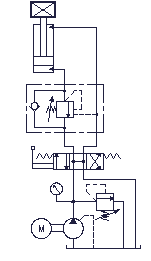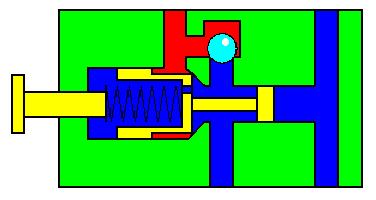- the opening pressure of a pilot operated checkvalve depends on the pressure (applied by the load) behind the valve;
- the opening pressure of a counterbalance valve depends on the spring pressure behind the valve.
The dynamic performance of a balance valve is many times better than the dynamic performance of a pilot operated check valve
As the load helps lowering the cylinder, the cylinder might go down faster than the oil is applied to the rod side of the cylinder (the cylinder isn't under control at that moment). However, the pressure at the rod side of the cylinder and therefore the pilot pressure on the balancevalve will decrease and the spring moves the balancevalve to the direction 'close' as long as it finds a new
When the direction control valve is suddenly put in the middle position while lowering the loaded cylinder, the counterbalance valve closes immediately. This will cause an increase of pressure at the bottom side of the cylinder. However, the counterbalance valve will open at the adjusted pressure and thus protects the cylinder against overpressure!
 The balancevalve is applied as a 'brake valve' on relatively small crane systems in order to get a positive control on a hydraulic cylinder or motor with a negative load.
The balancevalve is applied as a 'brake valve' on relatively small crane systems in order to get a positive control on a hydraulic cylinder or motor with a negative load.
Functioning (see diagram):
When the left side of the 4/3-direction control valve is activated the cylinder will make its 'OUT-stroke'. The oil flows through the checkvalve which is integrated in the housing of the balancevalve. In order to lower the cylinder, the right side of the 4/3-direction control valve has to be activated. From that moment on pressure is built up at the rod side of the cylinder. This pressure opens the balancevalve and the oil at the bottom side of the cylinder flows through the balancevalve and the direction control valve back to the reservoir.
